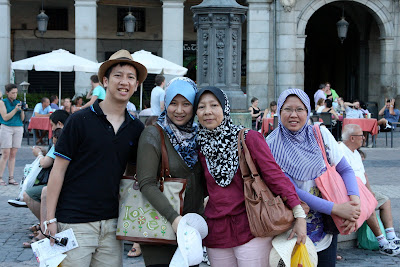
 Plaza Mayor adalah satu dataran yang dibina oleh Philip III bagi mengukuhkan lagi prestij dan keterampilan pemerintahan baginda. Komisyen kerja-kerja pembinaannya telah diserahkan kepada Juan Gomez de Mora dan pembinaannya bermula pada tahun 1617 dan siap dua tahun kemudian. Dataran ini sekarang mengandungi 136 rumah dan 437 'balconies' yang boleh memuatkan sehingga 50,000 orang bagi menyaksikan berbagai perayaan dan 'festivities' yang sering berlangsung di sini seperti: pertarungan dengan lembu jantan (bullfights), perkahwinan diraja, proklamasi diraja dan sebagainya.
Plaza Mayor adalah satu dataran yang dibina oleh Philip III bagi mengukuhkan lagi prestij dan keterampilan pemerintahan baginda. Komisyen kerja-kerja pembinaannya telah diserahkan kepada Juan Gomez de Mora dan pembinaannya bermula pada tahun 1617 dan siap dua tahun kemudian. Dataran ini sekarang mengandungi 136 rumah dan 437 'balconies' yang boleh memuatkan sehingga 50,000 orang bagi menyaksikan berbagai perayaan dan 'festivities' yang sering berlangsung di sini seperti: pertarungan dengan lembu jantan (bullfights), perkahwinan diraja, proklamasi diraja dan sebagainya.







Plaza Mayor, Madrid
History
The origins of the Plaza go back to 1589 when Philip II of Spain asked Juan de Herrera, a renowned Renaissance architect, to discuss a plan to remodel the busy and chaotic area of the old Plaza del Arrabal. Juan de Herrera was the architect who designed the first project in 1581 to remodel the old Plaza del Arrabal but construction didn't start until 1617, during Philip III's reign. The king asked Juan Gomez de Mora to continue with the project, and he finished the porticoes in 1619. Nevertheless, the Plaza Mayor as we know it today is the work of the architect Juan de Villanueva who was entrusted with its reconstruction in 1790 after a spate of big fires.Giambologna's equestrian statue of Philip III dates to 1616, but it was not placed in the center of the square until 1848. If you look around today you can still see the blood on the walls from some of the bull fights held in earlier years.
Names
The name of the plaza has changed over time. Originally it was called the "Plaza del Arrabal" but became known as the "Plaza Mayor".
In 1812, following a decree all the major plazas of Spain were renamed "Plaza de la Constitución", in honour of the Constitution of 1812. The plaza had this name until the restoration of the Borbón king in 1814 when it became known as the "Plaza Real". The plaza once again held the name "Plaza de la Constitución" in the periods from 1820 to 1823, 1833 to 1835, and 1840 to 1843.
In 1873, the name changed to "Plaza de la República", and then back to "Plaza de la Constitución" from the restoration of Alfonso XII in 1876 to the dictatorship of Primo de Rivera in 1922. A proclamation of the Second Spanish Republic gave the plaza the name of "Plaza de la Constitución" until the end of the Spanish Civil War when the plaza was renamed the "Plaza Mayor," the name it bears to date.
Uses
The Plaza Mayor has been the scene of multitudinous events: markets, bullfights, soccer games, public executions, and, during the Spanish Inquistion, "autos de fe" against supposed heretics and the executions of those condemned to death. The Plaza Mayor also has a ring of old and traditional shops and cafes under its porticoes. Celebrations for San Isidro, patron saint of Madrid, are also held here. The Plaza Mayor is now a major tourist attraction, visited by thousands of tourists a year.



































